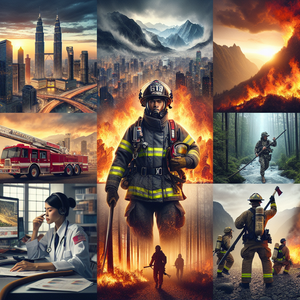
Exploring the Diverse Landscape of Firefighting Careers: From Urban Responders to Wildland Experts
The firefighting profession stands as a cornerstone of emergency response services, encompassing a wide range of specialized roles that meet the unique challenges posed by various environments. While many envision firefighters battling blazes in city streets, the reality is far broader, including vital positions in wildland firefighting, industrial safety, and beyond. Each role plays an essential part in safeguarding lives and property from the threats of fire and related emergencies.
Job Summaries:
Urban Firefighter:
- Urban firefighters are the frontline heroes responding to fires, hazardous materials incidents, and medical emergencies in densely populated areas.
- Their duties encompass controlling and extinguishing fires, rescuing individuals, providing emergency medical services, and performing fire safety inspections.
- Generally, candidates need a high school diploma, completion of a firefighter training program, and certifications in CPR and first aid.
Wildland Firefighter:
- Wildland firefighters specialize in combating blazes in forested and rural regions.
- They face challenges unique to these environments.
- They are responsible for creating firebreaks, conducting controlled burns, and utilizing specialized equipment to manage fire spread.
- Entry into this role typically requires a high school diploma and specific wildland firefighting training.
Fire Inspector:
- Fire inspectors play a pivotal role in fire prevention.
- Tasked with evaluating buildings for compliance with fire safety codes.
- Responsibilities include conducting inspections, reviewing architectural plans, and educating the public about fire safety measures.
- A background in fire science or a related field is generally required.
- Certifications in fire inspection are generally required.
Firefighter Engineer:
- Firefighter engineers operate and maintain fire apparatus.
- Ensuring that emergency vehicles are always prepared for action.
- This role requires a high school diploma.
- Specialized training in apparatus operation and maintenance.
Fire Captain:
- Fire captains lead and coordinate teams of firefighters during emergencies and training exercises.
- They manage personnel, oversee operations, and enforce safety protocols.
- To become a fire captain, candidates typically need several years of experience as a firefighter, along with leadership training and relevant certifications.
Airport Firefighter:
- Airport firefighters are specially trained to handle aviation emergencies.
- They handle aircraft fires and hazardous material spills.
- They complete rigorous training in aircraft rescue and firefighting techniques.
- Training often requires certifications in fire science.
- Additional aviation safety training is often required.
Fire Training Officer:
- Fire training officers are responsible for developing and implementing training programs for firefighters.
- They ensure firefighters are well-prepared for emergencies.
- This role requires a background in firefighting.
- Experience in instructional techniques is necessary.
Fire Marshal:
- Fire marshals oversee community fire prevention initiatives.
- They enforce fire codes.
- They investigate fire incidents.
- A degree in fire science or a related field is typically required for this role.
- Substantial firefighting experience is typically required for this role.
Hazardous Materials (HazMat) Technician:
- HazMat technicians respond to emergencies involving toxic substances and environmental threats.
- They are trained to identify hazardous materials and implement containment measures.
- Certification in hazardous materials response and safety procedures is necessary for this role.
Fire Investigator:
- Fire investigators play a crucial role in determining the cause and origin of fires.
- They often collaborate with law enforcement on arson cases.
- They collect evidence, interview witnesses, and analyze fire scenes.
Firefighter Type 2 (Crewmember):
- Firefighter Type 2 crewmembers work in teams to combat wildfires.
- They construct fire lines and monitor fire behavior.
- Entry-level positions usually require physical fitness.
- Completion of basic firefighting training is necessary.
Emergency Medical Technician (EMT):
- EMTs often collaborate with fire departments to provide medical assistance during emergencies.
- They assess patients, administer first aid, and transport individuals to healthcare facilities.
Fire Department Dispatcher:
- Dispatchers manage emergency calls and coordinate firefighting responses.
- They assess emergencies, relay critical information, and track unit statuses.
Civilian Fire Department Staff:
- Civilian staff members support fire departments through administrative and logistical roles
- Including budgeting and public relations.
Wildland Fire Module Leader:
- Module leaders oversee specialized wildland firefighting teams
- Ensuring safety protocols are adhered to
- Operations are coordinated effectively
Fire Department Public Information Officer:
- Public information officers manage communications between fire departments and the community
- Especially during emergencies
Firefighter Recruit:
- Recruits undergo intensive training to become certified firefighters
- Focusing on physical conditioning
- Focusing on firefighting techniques
- Focusing on emergency medical response
Fire Safety Educator:
- Fire safety educators promote awareness and prevention strategies within communities.
- They develop educational materials and conduct workshops to teach fire safety principles.
Fire Apparatus Technician:
- Fire apparatus technicians maintain firefighting equipment.
- Fire apparatus technicians repair firefighting vehicles.
- Technicians ensure compliance with safety standards.
Fire Department Chaplain:
- Fire department chaplains provide emotional and spiritual support to firefighters and their families
- Support is especially important during traumatic events.
These varied roles within the firefighting profession not only showcase the multitude of career paths available but also emphasize the significance of each position in enhancing community safety and emergency preparedness. For those interested in pursuing a career in firefighting, it’s beneficial to explore current job openings, training requirements, and specific pathways that align with their skills and aspirations.
Explore More Jobs

